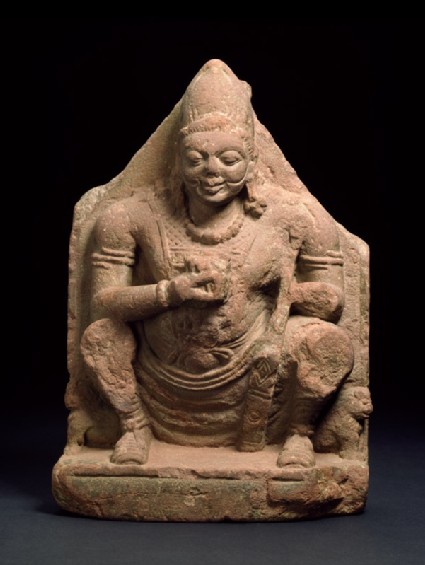Search Results: objects
Show search help- Reference URL
Actions
Figure of Surya, the Sun god
-
Description
Surya is shown in the costume of a Kushan ruler, with boots, tunic and cap.
-
Details
- Associated place
-
Asia › India › north India › Uttar Pradesh › Mathura district › Mathura (place of creation)
- Date
-
5th century AD (AD 401 - 500)
Gupta Period (AD 320 - 600)
- Material and technique
- red sandstone
- Dimensions
- 23.5 x 15 x 5.5 cm max. (height x width x depth)
- Material index
- Technique index
- Object type index
- No. of items
- 1
- Credit line
- Purchased, 1972.
- Accession no.
- EA1972.45
-
Further reading
Harle, J. C., and Andrew Topsfield, Indian Art in the Ashmolean Museum (Oxford: Ashmolean Museum, 1987), no. 25 on p. 20, pp. 12 & 26, illus. p. 20
Harle, J. C., Gupta Sculpture: Indian sculpture of the Fourth to the Sixth Centuries A.D. (Oxford: Clarendon Press, 1974), fig.51
London: Asia House Gallery, Autumn 1978, The Ideal Image: The Gupta Sculptural Tradition and its Influence, Pratapaditya Pal, ed. (New York: Asia Society in association with J. Weatherhill, 1978), no. 5
Vienna: Kunsthistorisches Museum, 2 April-16 July 1995, Buddha in Indien: Die frühindische Skulptur von König Asoka bis zur Guptazeit, Deborah E. Klimburg-Salter, ed. (Vienna: Kunsthistorisches Museum and Milan: Skira, 1995), no. 222 on p. 231, illus. p. 231 fig. 222
Ahuja, Naman, ‘Early Indian Art at the Ashmolean Museum - Catalogue in progress’, 2016, no. 104.3
Location
Objects are sometimes moved to a different location. Our object location data is usually updated on a monthly basis. Contact the Jameel Study Centre if you are planning to visit the museum to see a particular object on display, or would like to arrange an appointment to see an object in our reserve collections.
Galleries
Publications online
-

Indian Art in the Ashmolean Museum
The udīcya (northern) costume, featuring boots, a sort of tunic and a soft cap, its point tilted forward, first appears in Gandhara and Mathura around the first century of our era in depictions of the foreign people to whom the Kuṣāṇa rulers belonged. The squatting position makes a similar appearance at Mathura at this time, adopted by images of Sūrya, Hārītī [see EA1971.36] and some little figures of mother-goddesses (mātṛkās).
The figure holds a small bowl (?) topped by a lotus blossom in his right hand; his left probably held a sword, of which only the bottom of the scabbard remains. Two little sitting lions, in profile on either side, recall the lion throne of some Kuṣāṇa princes or kings, whereas Sūrya is associated with the seven horses who draw his chariot, thus raising the question, as to whether some other images of the period, as to whether or not this is the Sun-god. Later, Sūrya is unmistakably identified by the presence of two attendants.
The sculpture is notable for its detail and the crispness of the carving. Whether the deeply cut lines around the sides and lower parts of the face outline a beard (some Kuṣāṇa kings are shown bearded on their coinage) or a faceguard, it is difficult to say.
© 2013 University of Oxford - Ashmolean Museum



